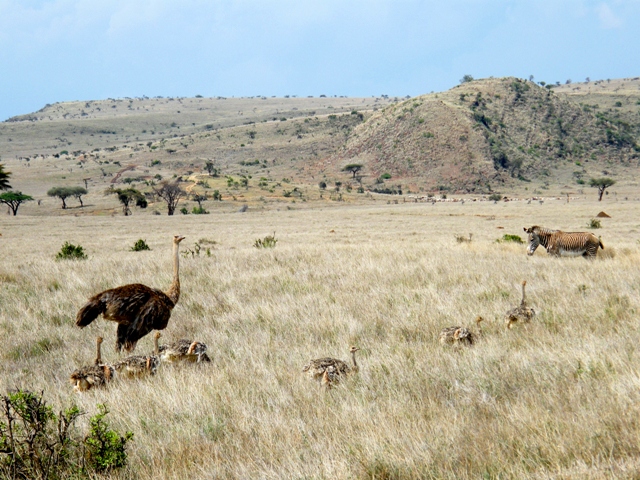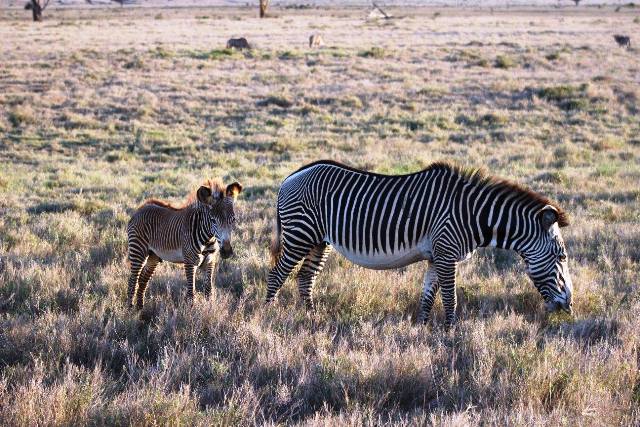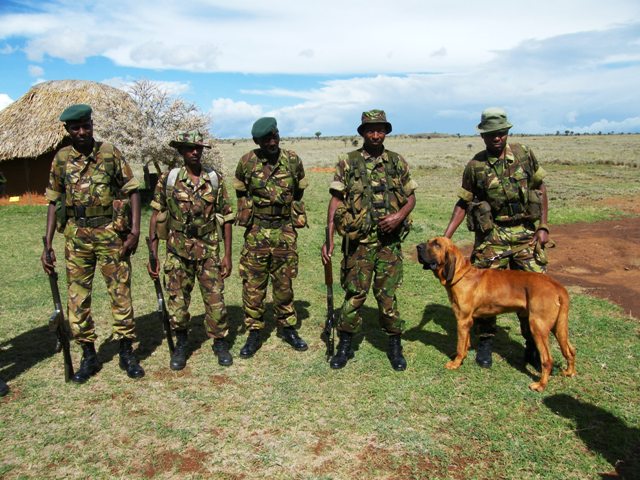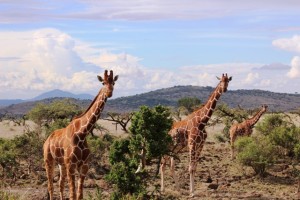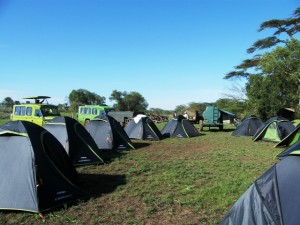Written by Arjun Dheer, Becca Sargent & Sian Green
It was with huge excitement and anticipation that we set off for our 10 day field trip to Kenya last month. For several of the team it was their first time in Africa and for the rest it was a welcome return to one of our favourite places! After a long and tiring journey, it was with some trepidation that we set up our tents at the research base within Lewa Wildlife Conservancy. Fortunately, despite being inexperienced campers, our tents survived the entire trip without collapsing or letting in any water! Feeling very excited, we then jumped into the cars to go for our first game drive and Lewa certainly did not disappoint! Within minutes we had our first sighting of a beautiful white rhino with her young calf and on the other side of the cars we had an elephant herd making their way towards us. It was an incredible introduction to Lewa and before the end of the drive we had many more species to add to our list from Grevy’s zebra, to buffalo, to giraffe.
The following day the real work began! The aim of our trip was to put into practice some of the monitoring techniques that we had learned about so far on the MRes Wildlife Conservation course by completing a different activity each day. We began by driving some transects to collect data on large mammal abundance via distance sampling, which involved the use of a variety of equipment including GPS, range finders, binoculars and compasses. Whenever we spotted any animals we noted down the number, species and distance from the vehicle. On return to camp, we inputted our data into a program called DISTANCE, which although was a challenge and very much a trial due to having a small dataset, allowed us to calculate some density estimates for wildlife across Lewa.
The second field technique we practiced was the use of ethograms to study animal behaviour. Our focal species was the endangered Grevy’s zebra, Equus grevyi, for which Lewa is an important stronghold. After a brief introductory lecture, we split into two groups to design our ethograms with a focus towards vigilance behaviour. Data collection involved recording the behaviour for each individual zebra in a group, every two minutes, for a 30 minute period. We soon found that in large groups keeping track of individuals was easier said than done, but with a bit of practice and teamwork we soon got the hang of it! Although our sample sizes were too small to statistically analyse in detail, it was a great opportunity to practice in the field and to spend some time observing the Grevy’s zebra in the wild.
Our next survey was looking at vegetation rather than the animals themselves! Vegetation monitoring is extremely important for Lewa as livestock grazing has been implemented as part of their land management and so evaluating its impact on vegetation is paramount. We used a method that required only a data sheet and a 1m length stick to give a quick assessment of vegetation cover to compare an area that had been grazed by cattle with one that had only had natural grazing from wild animals. This particular surveying technique has recently been rolled out to local communities as part of community outreach programs allowing communities to keep track of the health of their own land.
Another important activity that we conducted whilst at Lewa was a Grevy’s zebra foal patrol survey. We drove around different sections of the conservancy to conduct a census on the Grevy’s zebra population which was then collated into a national database. The technique was to note down demographic information, such as age and sex, and to obtain right side flank photos of each individual; each zebra has a pattern of stripes as unique as our own fingerprints which can be differentiated via these flank photographs using a software program called Image Based Ecological Information System. Despite the day being very long and at times relatively challenging, we soon became quite adept at it and felt very privileged to have the opportunity to contribute to such an important aspect of Lewa’s conservation work.
A major highlight of our time at Lewa was a special surprise that Dr Zeke Davidson, Marwell Wildlife’s field biologist in Kenya, has organised; we got to meet Lewa’s anti-poaching unit, including one of their most important members, a male bloodhound. This included a demonstration of the ability of these dogs to track down poachers by simply utilizing the scent of an individual’s foot print. The unit also explained to us the sort of work they conduct and the major issues they come across while defending Lewa’s wildlife, particularly rhinos, from poachers. Arjun had the privilege of being the main poacher that the dog would track, along with accomplices Sian and Becca. The bloodhound was exposed to his scent and then the three of them, along with two armed members of the anti-poaching team, wandered off into the grassland and hid in a ravine to await their unavoidable destiny. After a short period of time, the anti-poaching team as well as the rest of the students and Zeke were led directly to where they were hiding!
With our time in Kenya drawing to a close we packed up camp and headed to our final stop, El Karama, a private cattle ranch situated to the west of Lewa. It was extremely interesting to see the much greener landscape at El Karama as they had clearly already had much more rain than at Lewa. After spending the morning in camp practising some vehicle maintenance and changing tyres we headed out to explore the ranch. Unfortunately, as we set off the heavens opened! We arrived at the bomas where the cattle were kept and Zeke gave us a brief overview of how they carefully manage the cattle so that they can co-exist with the wildlife and preserve the balance of the ecosystem. We then began the slow and slippery drive back to camp, unfortunately scarcely seeing any animals along the way due to the downpour. Soon we came across an area resembling a swamp, with large pools of water rapidly forming on the open grass: our camp! With our tents almost floating away we hurried to gather our belongings, which miraculously had stayed dry, and stashed them safely in the car. Having re-built camp further up the hill, we sought shelter under the large communal tent beside the kitchen area and the rain hardly abated for the rest of the night.
- Giraffe, Giraffa camelopardalis
- Camp at El Karama Cattle Ranch
Our time in Kenya had come to an end and nobody was particularly pleased about having to return to a cold, grey Southampton and begin work on our many assignments! Overall, it was a fantastic trip! We learned a lot of new techniques, saw a huge variety of wildlife and experienced delicious food and great company along the way. Thank you to everyone at Lewa Wildlife Conservancy, El Karama and Marwell Wildlife for taking care of us!
Posted By : Kezia Bellamy

